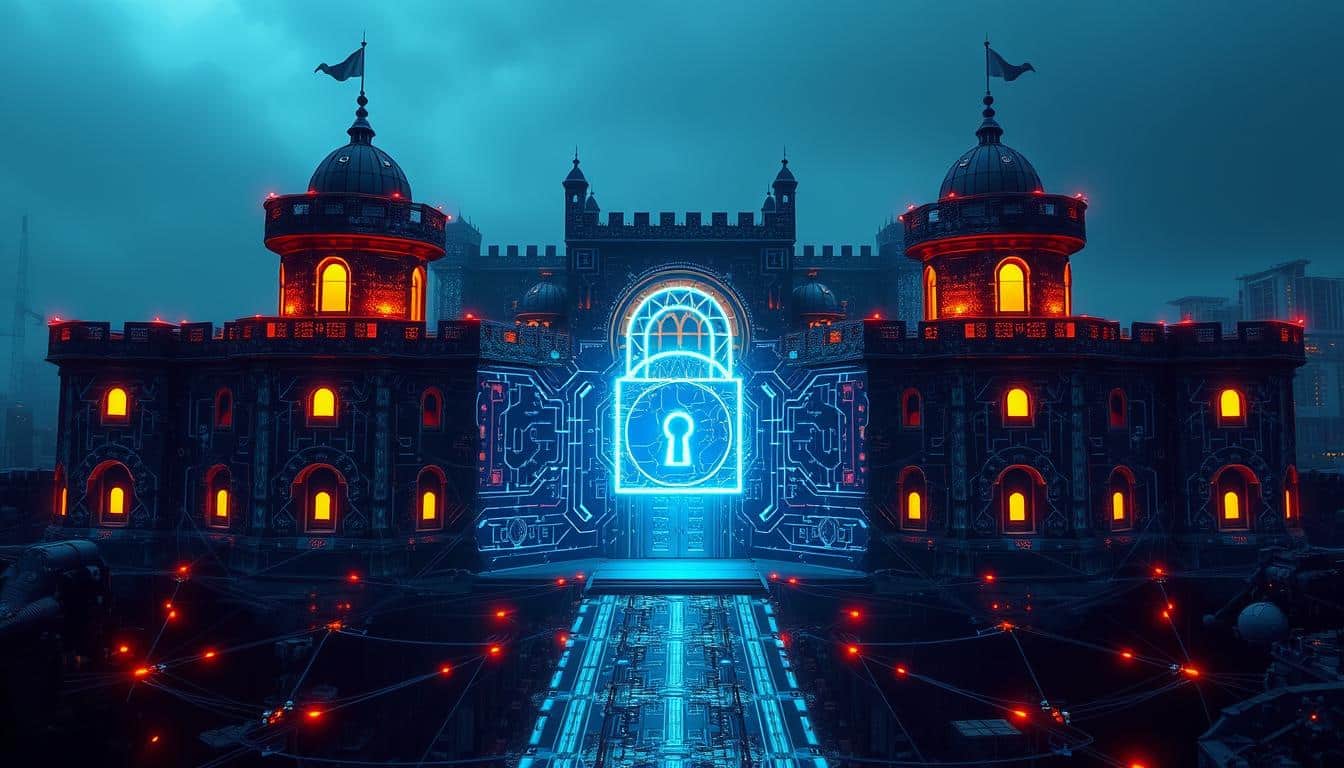In 2014, the crash of Mt. Gox led to the loss of 850,000 BTC. That was worth $460 million then1. This event was a wake-up call to the crypto world. It showed that keeping digital assets safe is key to handling your investments right.
It’s easy to confuse crypto exchanges with wallets because they seem similar. But, they are different in important ways that impact the safety and ownership of your digital assets. Exchanges let you buy, sell, and trade cryptocurrency. Wallets, however, let you manage your money on the blockchain with private keys. Understanding these differences is crucial for protecting your investments and keeping control of your digital currency.
Key Takeaways
- Crypto exchanges are not the same as crypto wallets.
- Mt. Gox’s fall highlighted the risks of keeping assets on exchanges.
- Exchanges provide convenience but lack true ownership of assets stored on them.
- A wallet ensures control over your private keys and enhances cryptocurrency security.
- Understanding the difference between an exchange and a wallet can help you better protect your digital asset storage.
The Difference Between Crypto Exchanges and Wallets
It’s key to know the difference between a crypto exchange and a crypto wallet. This awareness helps you use the right tools for trading and protecting your digital money.
Definition of a Crypto Exchange
A crypto exchange is like an online shop for buying, selling, and trading cryptocurrencies like Bitcoin and Ethereum. Exchanges like Coinbase and KuCoin also offer extra services. They give you wallet options, loans, and a way to change digital money to regular money. KuCoin has over 700 types of cryptocurrencies and trades $1.37 billion daily. It’s known worldwide2. Coinbase, famous for being safe and easy to use, has more than 30 million users worldwide2. Using exchanges lets you trade quickly and easily2. But, 67% of exchanges face more risks of attacks and mistakes than wallets do3.
Definition of a Crypto Wallet
A crypto wallet can be hardware or software. It keeps your transaction keys safe. You can choose desktop, mobile, or physical USB-like hardware wallets for extra safety2. Wallets let you control your keys and lower the risk from exchange problems or tech glitches2. Studies show 82% of crypto users trust wallets more for their security and reliability than exchanges3.
About 25% go for hardware wallets for even more security3. Now, 90% of wallets are ‘light’, saving space and making them easy to use3.
Choosing between an exchange or a wallet depends on your needs. Think about the risk you can handle and how much control you want over your digital assets2.
Types of Crypto Wallets
Exploring the crypto world, it’s key to know about private keys and safe wallet choices. Different crypto wallets have various security and ease levels. Each is made for certain needs and likes.
Desktop Wallets
Desktop wallets are apps installed on your computer. They give a mix of safety and ease. Stored on your own machine, desktop wallets face fewer cyber-attacks than web wallets. This makes them liked by many fans4.
They also boost privacy more than web wallets by stressing the key role of private keys for safe trades4.
Mobile Wallets
Mobile wallets run on smartphones, making using your crypto easy and quick. Yet, they have a higher chance of malware and other security risks due to being online and flexible4. Still, mobile wallets are good for keeping your crypto handy while on the move.
Web Wallets vs. Exchange Wallets
Web wallets, accessed via internet browsers, are very user-friendly but open to cyber-attacks4. Exchange-provided, they swap higher risk for convenience. In contrast, exchange wallets keep your crypto on their site. This makes trading simpler but raises the risk of losses through hacks or exchange issues54. Knowing these variances helps in choosing safe wallets.
Paper Wallets
Paper wallets are an offline, physical way to store your crypto. They mostly come as a printed QR code with your keys. Although safe from online dangers, they’re missing security features, which makes moving some funds hard4. Keeping the paper safe is crucial for protecting your money.
Hardware Wallets
Hardware wallets work like USB devices and keep your keys offline for top security. They’re seen as better than hot wallets as they avoid internet threats4. Ideal for keeping investments long term, they show the vital role of private keys in controlling your funds4.
How Crypto Exchanges Work
Crypto exchanges are key platforms for trading cryptocurrencies. They let you buy and sell digital assets with money or other cryptocurrencies. Knowing how these exchanges operate is vital for anyone dealing with digital currencies.
Overview of Centralized Exchanges (CEXes)
Centralized exchanges (CEXes) are run by a single company that oversees all activities. These exchanges handle trades, store digital assets, and manage user interactions. Examples like Kraken and Coinbase are well-known. Kraken offers transaction fees from 0.00% to 0.40% and supports over 200 cryptocurrencies. Meanwhile, Coinbase has over 5,500 assets in its wallet with fees up to 0.60%. Both provide strong systems for easy trading for their users6.
CEXes bring all trading to one place. This means more liquidity and support for users. But, it also brings bigger risks like hacking or misusing funds7.
Overview of Decentralized Exchanges (DEXes)
On the flip side, decentralized exchanges (DEXes) use a peer-to-peer network for direct user transactions. This setup gives you more privacy and control, as no single authority has your data or funds. While they have lower liquidity, DEXes attract with fewer fees and less red tape. Users who value privacy and self-governance find DEXes, like Uniswap, favorable for crypto trading7.
The Risks of Keeping Crypto on an Exchange
Cryptocurrency security is a big worry for investors using exchanges like Coinbase, Kraken, and Gemini. The risks of keeping your money on these platforms are big.
Hacking Concerns and Historical Examples
Hackers often target crypto exchanges, leading to loss of data and money. The Mt. Gox hack in 2014 saw 850,000 Bitcoins stolen. This caused huge losses for users and led the exchange to bankruptcy8910. Another hack hit Crypto.com in January 2022, resulting in a $35 million loss9. Despite using strong security steps like 2FA and SSL encryption, risks remain10.
Adding extra security layers like multi-factor authentication (MFA) helps. But, your digital money is still at risk8.
Legal and Regulatory Issues
The laws around cryptocurrency are always changing and struggle to keep up with its fast growth. Many big crypto exchanges aren’t registered with agencies like the SEC, meaning there’s no investment insurance if they go bankrupt89. Also, the protections for depositor funds that apply to securities brokers don’t cover crypto exchanges9.
Because of this, customers of exchanges don’t have the same protections as bank depositors with FDIC insurance9. If an unregistered crypto exchange fails, customers might lose everything they have in digital assets9.
Potential for Exchange Closure
Exchanges can close suddenly, as seen with Mt. Gox’s collapse. This leaves investors without help8910. FTX and Voyager also stopped customer withdrawals before going bankrupt, causing big losses for users910. These events show the risks of not moving your assets to a personal wallet.
To reduce risks, using a noncustodial wallet is smarter. It gives you full control and a way to recover access if needed8.
Importance of Private Keys
Understanding the role of private keys in crypto security is vital. They are like the “master password” for your crypto wallet, protecting your digital money from unwanted access1112. With 91% of crypto investors focusing on security when picking a wallet, keeping your private key safe is key11.
Private keys are long codes. For ease, wallets give a seed phrase of 12-24 words during setup12. Some people keep their keys on paper or metal sheets for extra safety against online and physical dangers12.
Owning your private keys means you really own your crypto. Over 85% of savvy investors use non-custodial wallets for more control and security11. Also, 67% prefer hardware wallets for storing big crypto amounts safely offline, thanks to private keys11.
Private keys also help in making blockchain transactions by signing off on them digitally. Keeping keys safe ensures your transactions are trusted and valid12. This shows how essential private keys are for crypto security as a whole.
Why Your Exchange Isn’t a Wallet (And Why It Matters)
When you keep cryptocurrencies on an exchange, you might think you control them. But this is just a false sense of ownership.
False Sense of Ownership
Holding cryptocurrency on an exchange doesn’t mean you own it. In fact, the exchange controls the private keys. This means you’re trusting them to keep your assets safe13. This is called custodial storage. The exchange looks after your digital assets for you13. Centralized exchanges (CEXes) are in charge of this. However, they can be risky due to hacking and scams14.
The fall of exchanges like FTX in 2022 shows these dangers. It shows why trusting only custodial storage is risky15.
Custodial vs. Non-custodial Storage
The main difference between custodial and non-custodial storage is who’s in control. Custodial storage means the exchange holds your keys. A non-custodial wallet gives you complete control and ownership of your keys14. With non-custodial storage, you handle your keys. This ensures you really own your assets and boosts security by cutting out the middleman14.
Non-custodial wallets let you safely store, send, and receive cryptocurrencies. They also let you use decentralized apps, join DeFi activities, and take care of digital identities15. Even though you have to manage your keys, the security of non-custodial wallets is stronger than the risks of custodial storage14.
Hot Wallets vs. Cold Wallets
Understanding the difference between hot wallets and cold wallets is key for cryptocurrency security. Each type offers unique benefits and fits different needs in the crypto space.
Differences and Use Cases
Hot wallets, like web-based, mobile, and desktop wallets, are always online. This makes them perfect for regular transactions16. They include Metamask, Trust Wallet, and Coinbase Wallet. These wallets are easy to use, ideal for daily Web3 activities, NFTs, DeFi, and gaming17. Yet, being online all the time puts them at a higher hacking risk16.
In contrast, cold wallets (e.g., Ledger, Trezor) and paper wallets stay offline. This makes them much safer against online attacks16. They’re like secure vaults for your crypto, protecting your private keys from hackers18. For storing vast amounts of cryptocurrency for a long time, cold wallets are the best choice.
Security Levels
Comparing the security of hot wallets and cold wallets is vital. Hot wallets can be risky, as they’re exposed to online threats18. Still, they provide safety features like fingerprint locks and QR code scanning for added protection17.
On the other hand, cold wallets keep your private keys offline. This greatly reduces risk from online dangers18. Devices like the Ledger Nano X and S Plus are nearly impossible to hack. They cost from $50 to $300 but offer unmatched security17.
Using both hot and cold wallets gives the best of both worlds. Hot wallets for everyday use and cold wallets for safe, long-term storage of bigger crypto amounts16. This mix enhances both ease and security in managing your digital assets. Discover more by reading this guide16.
| Wallet Type | Accessibility | Security Level | Cost | Examples |
|---|---|---|---|---|
| Hot Wallet | High (Internet Required) | Moderate | Mostly Free | Metamask, Trust Wallet, Coinbase Wallet |
| Cold Wallet | Low (Offline Storage) | Very High | $50 – $300 | Ledger, Trezor, Paper Wallet |
Best Practices for Crypto Wallet Security
To keep your crypto safe, learning and using the right security steps is key. Keeping private keys safe and using multiple security checks are vital.
Safeguarding Private Keys
One important rule is to always protect your private keys. It’s crucial to store keys somewhere safe but physical to avoid losing them if your device breaks or you make a mistake19. Using different places and gadgets for storing your crypto can help protect it from disasters19.
Many people have lost their crypto because they forgot their passwords or didn’t have a backup of their seed phrases19. And every year, a lot of money in crypto is gone forever because the owners died without sharing their passwords and seed phrases with their families19. To avoid these issues, creating strong passwords with a mix of characters is advised20.
Using Multi-Factor Authentication
Adding multi-factor authentication (MFA) is another key practice for keeping your crypto wallet secure. MFA asks for more than just a password to get in. With two-factor authentication (2FA), for instance, the risk of someone else getting into your account drops significantly20.
Using wallets that need multiple approvals from different devices and places is also smart. This makes your wallet more secure21. Setting up warnings for any strange activity in your account is helpful too20.
Following these guidelines, you can keep your digital money safe in the unpredictable crypto world.
Scenario-Based Wallet Recommendations
Choosing the right crypto wallet affects your experience and safety. Whether you’re a newbie, a pro trader, or a crypto fan, there are secure wallet options just for you. Here, we have recommendations for various needs, following crypto wallet best practices.
New Users
For newbies, it’s key to pick a wallet that’s easy and safe to use. Custodial wallets from places like Coinbase and Binance are great for starters. These wallets connect with the exchange, so you can deal with assets easily. This setup makes transactions smooth and is newbie-friendly22. Yet, these wallets have risks like hacks and cyber threats22.
Experienced Users
If you’re more seasoned with crypto, try mixing hardware and mobile wallets. Hardware wallets, such as Ledger and Trezor, keep your keys offline for extra safety. They’re best for storing lots of crypto for a long time22. Mobile wallets like Trust Wallet and MetaMask let you manage funds anywhere and support many assets23. This mix offers you quick transactions and strong security for your savings.
Crypto Enthusiasts
If you’re deep into crypto, go for top-notch security methods. Multi-sig wallets need several keys for a transaction, upping your security. It’s smart to mix hot and cold storage. Use Exodus for daily trading and Ledger for storing most of your crypto2223. Crypto.com DeFi Wallet and Guarda also offer great asset management with support for many assets23.
By matching your experience with crypto wallet best practices, you’ll find the perfect secure wallet options. This ensures easy use and top security.
Real-World Examples of Exchange Failures
It’s important to know why exchanges aren’t like wallets. Let’s look at past crypto exchange problems to understand better.
The fall of Mt. Gox is a big lesson. It managed over 70% of all Bitcoin deals worldwide. In 2014, it went bankrupt after losing 850,000 Bitcoins, worth about $450 million, due to hacking and poor management. This event showed the dangers of keeping assets on exchanges and prompted the search for safer digital asset storage.
In 2022, almost $23.8 billion in cryptocurrency was sent to illegal addresses, a 68% jump from the year before. Central exchanges received almost half. This shows how exchange weaknesses can help illegal activities24.
Hackers have taken advantage of these flaws. 57% of stolen crypto funds went to DeFi protocols. More than half from shady addresses ended up at central exchanges. This shows how important strong security and knowing the difference between exchanges and wallets is24.
Moreover, 915 fiat off-ramping services handled illegal crypto, with five exchanges holding nearly 68% of these funds. This increase from 56.7% in 2021 to 67.9% in 2022 shows the big risks when exchanges don’t have strong security and regulations24.
Exchange failures aren’t just about hacks. Rules, or the lack of them, also pose big risks. With less regulation than traditional markets, issues like wash trades and insider trading hurt investors. The U.S. Commodities and Futures Trading Commission has flagged problems like flash crashes, manipulation, theft, and more, pointing out significant dangers25.
Knowing these risks and past exchange failures can guide you in safely storing your digital assets. An exchange isn’t a wallet, and understanding this difference is crucial for protecting your investments.
Steps to Move Crypto from an Exchange to a Wallet
Moving crypto from an exchange to a wallet is key for security. Having private keys means you fully control your funds. Follow this guide to transfer your assets safely.
Creating a Self-Custody Wallet
The first step involves creating a self-custody wallet. This wallet type ensures you hold the private keys, offering complete control. For software wallets, Coinomi is a good choice as it supports ShapeShift and Changelly for cheaper withdrawals26. On the other hand, Ledger and Trezor are hardware wallets that keep your keys offline, boosting security.
Transferring Assets
After setting up your wallet, note your new wallet address. Go to your exchange account, pick the cryptocurrency to transfer, and start the withdrawal to your wallet address. Remember, network fees can change; for Bitcoin, they might be a few dollars or up to $60 during busy times27. Also, withdrawal times might range from 30-60 minutes on platforms like Binance26. And, some fees can apply for small deposits; for example, Bitfinex has a fee for deposits under $1,00026.
Verifying the Successful Transfer
After you transfer, it’s vital to check if the assets reached your wallet. Use a blockchain explorer to monitor the transaction. This ensures your digital assets are safe and confirms you control your funds because of your private keys.
For more insights into affordable crypto options and wallet security tips, check out this article.
Conclusion
Understanding the difference between crypto exchanges and wallets is key for anyone into digital assets. Crypto exchanges are mainly for trading, while wallets keep your assets safe. It’s vital to get this, especially since hackers stole over $3.8 billion in cryptocurrency in 2022. This highlights the risks of keeping assets on exchanges28.
Knowing about private keys and choosing secure storage like Ledger and Trezor hardware wallets can boost your crypto security. Keeping your private keys safe is crucial. If you lose them, you could lose all your assets29.
More and more people in America are using digital wallets for their everyday transactions. They find these apps handy and secure30. It’s clear, then, that knowing how to protect your crypto wallet is more important than ever. This ensures the safety of your investments in our digital age.









